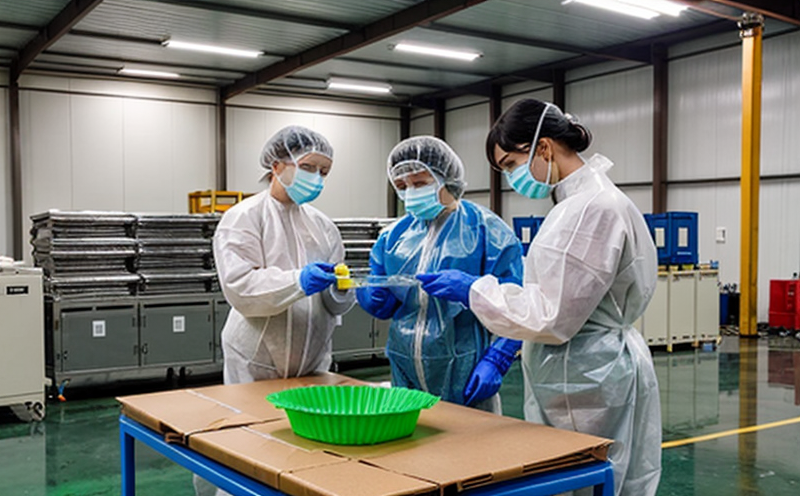ISO 2556 Resistance to Internal Pressure Testing
The ISO 2556 resistance to internal pressure test is a critical method used in plastic packaging testing to assess the integrity of packaging materials under pressurized conditions. This test evaluates how well a material can withstand internal pressures, which are common during filling and sealing processes.
This test is particularly important for ensuring that packages do not burst or leak during production, storage, and transport. The pressure applied simulates real-world scenarios where packaging might be subjected to higher-than-ambient pressures, such as in a pressurized container or during filling operations.
The test involves placing the specimen under controlled internal pressure for a specified duration. The specimen is then observed for any signs of deformation, leakage, or failure. This procedure helps manufacturers and quality assurance teams identify potential weaknesses in their packaging designs early on, preventing costly recalls and ensuring product safety.
Key factors that influence the outcome of this test include the type of plastic used (polyethylene, polypropylene, etc.), thickness, and the design of the package. The apparatus used for this test must be precise to ensure accurate results. ISO 2556 specifies the use of a pressurized vessel designed to apply internal pressure uniformly across the specimen.
Understanding the standard requirements is essential for achieving reliable outcomes. According to ISO 2556, the pressure should be applied gradually and held at that level for a specified time duration. The test can also involve cyclic pressure applications to simulate real-world conditions more accurately. This method helps in identifying materials that may fail due to fatigue or gradual weakening over time.
The results of this test are crucial for quality managers, compliance officers, and R&D engineers involved in the development and production of plastic packaging. By ensuring that packages can withstand internal pressure without failure, these professionals can enhance product safety, reduce waste, and improve brand reputation.
Why Choose This Test
The ISO 2556 test is chosen for plastic packaging testing because it provides a reliable method to evaluate the integrity of materials under pressurized conditions. For quality managers and compliance officers, this test ensures that packages meet regulatory standards and customer expectations. R&D engineers benefit from its ability to identify weaknesses in design early in the development process.
By conducting this test, manufacturers can ensure that their packaging is robust enough to withstand the pressures encountered during filling and sealing processes. This reduces the risk of leaks or bursts, which could lead to product contamination or damage. Additionally, it helps in maintaining a consistent quality level across production batches, thereby enhancing brand reputation.
The test also aids in meeting compliance requirements set by various international standards such as ISO 2556 and ASTM D1890. Compliance officers can use the results of this test to ensure their products meet these stringent standards. This not only helps in avoiding legal issues but also enhances customer trust.
For procurement teams, choosing materials that pass this test ensures they are selecting high-quality suppliers who adhere to strict testing protocols. This reduces the risk of purchasing substandard materials and improves overall supply chain efficiency.
Competitive Advantage and Market Impact
Implementing ISO 2556 resistance to internal pressure testing can provide significant competitive advantages in the market. By ensuring that packaging meets or exceeds industry standards, companies can differentiate themselves from competitors who may not adhere to such rigorous testing protocols.
The test results can be used as a marketing tool to highlight the quality and reliability of products. This can attract customers seeking dependable packaging solutions, thereby increasing brand loyalty and market share. Moreover, meeting regulatory requirements ensures compliance with international standards, which is crucial for exporting products to different regions.
From an operational perspective, reducing the risk of package failures leads to cost savings in terms of reduced waste and rework. It also minimizes the need for costly recalls and product replacements, thereby enhancing overall efficiency. This can translate into higher profit margins and better resource utilization.
In summary, ISO 2556 resistance to internal pressure testing is not just a compliance requirement but a strategic tool that helps companies stay ahead of the competition by ensuring superior packaging quality.
Use Cases and Application Examples
| Application Example | Description |
|---|---|
| Flexible Polyethylene Bags | The ISO 2556 test is used to ensure that flexible polyethylene bags can withstand the internal pressure generated during filling and sealing processes. This helps in preventing leaks and bursts, ensuring product integrity. |
| Blister Packs | This test assesses the integrity of blister packs under pressurized conditions to ensure they remain intact during shipping and storage. It is particularly useful for pharmaceutical products that require airtight packaging. |
| Bottle Liners | The resistance to internal pressure test evaluates bottle liners used in beverage containers, ensuring they can withstand the internal pressure without failure. This helps maintain product quality and safety. |
| Pallet Wrap | This test is crucial for pallet wrap used in logistics and supply chain management. It ensures that the packaging remains intact under pressurized conditions, providing better protection during transportation. |
| Food Packaging | The ISO 2556 test is particularly important for food packaging to ensure it can withstand internal pressure without compromising product safety or quality. This is essential for maintaining freshness and preventing contamination. |
| Bulk Containers | This test evaluates bulk containers used in industries such as chemicals, pharmaceuticals, and agriculture. It ensures that the packaging can withstand internal pressure during filling and transport without failure. |





